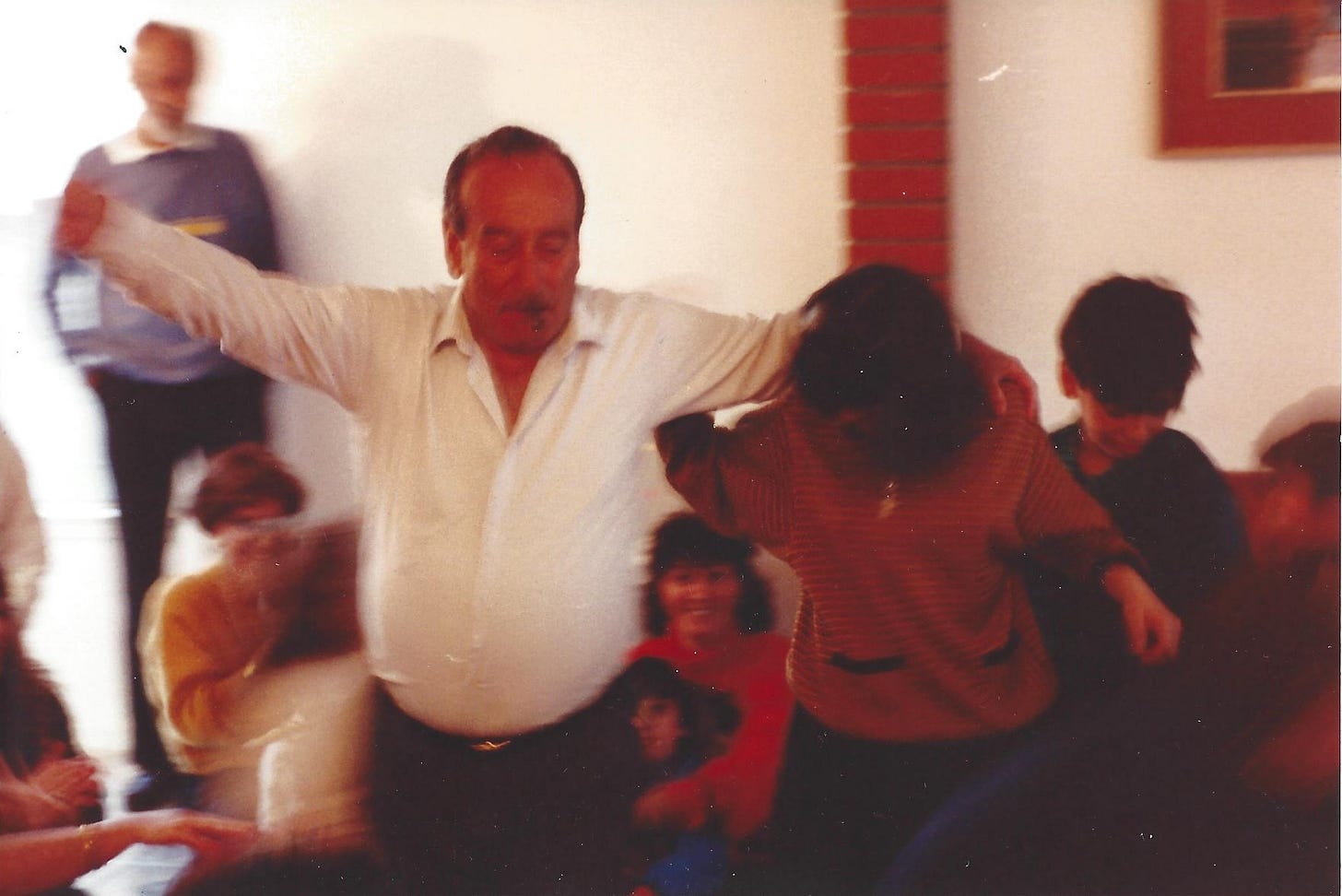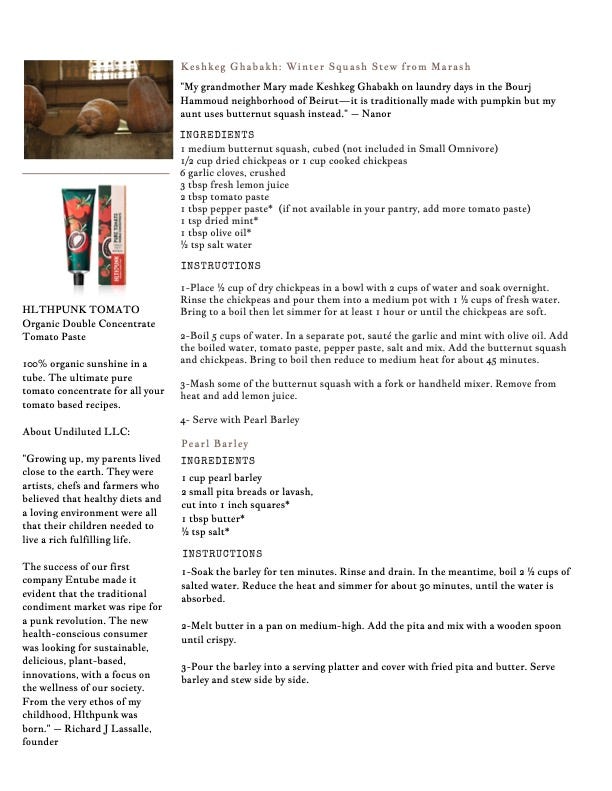One of the most beautiful boxes we created during my company’s farm to table days grew out of the Armenian community living in LA. Nanor Abkarian, who generously spent hours creating these recipes, during the pandemic no less, drew from an incredible array of family recipes, and wove her memories of food into the story telling. Sales of this box donated $515 to the Armenia Fund in 2020, but I’d love for this effort to raise more: if you enjoy this post and the associated recipes, please donate HERE to ArmeniaFund, which was Nanor’s non profit of choice. This project is one of the most beautiful food narratives we created over the years, and was particularly poignant when we produced it during an acute period of bombardments of the persecuted Armenian people.
The recipes are from Nanor Abkarian’s kitchen and stories from across the Armenian diaspora... In addition, below you will find an essay, There Was and There Wasn’t, about her family story and identity, that Nanor wrote.
Nanor, whose family photos and recipes are the basis for this project, started the journey with these words:
"When I think of Armenian food, I think of apricots, pomegranates, seeds handpicked from giant sunflowers, golden honeycombs, and hearty stews...Armenian food is Lebanese food, Syrian food, Iranian, Turkish, Ethiopian, French, Argentinian, et al. When I think of Armenian food, I think of my grandmother’s hands kneading dough, my uncles barbecuing kebab and offering steaming bites folded into pita; I think of my aunts—their individual specialties and their collective magic: the ability to transform any space into a world of abundance. Armenian food is family. It is music and laughter and dancing in celebration of the simple fact that we are here, and we are together." – Nanor
Featured Recipes (click individual recipe titles, to find the recipe)
"My most vivid memory of my great-grandmother Lydia is of her wrapping cabbage to make Gaghampi Patuyt: its preparation is often a shared experience between friends and neighbors."– Nanor
“Calls to Aleppo in recent years have been about the turmoil in the region and often come to a standstill, but asking my grandmother Zvart for recipes shifted the conversation and brought us closer to one another – it took many international phone cards to try and translate her measurements”– Nanor
There was and there wasn't... by Nanor Abkarian
There was and there wasn’t a song about the Armenian kingdom of Cilicia. It is only one of many songs that capture our sense of longing, and I recall finding my great-grandmother, an orphan of the Armenian genocide, singing for Cilicia while recording her voice on a cassette tape.
There was and there wasn’t is the way that all Armenian folk tales begin. I have a hunch this speaks to our history: the kingdoms that were and weren’t, the drawing and redrawing of borders, and a severance from magnificent mountain ranges through which our understanding of the cosmos has been shaped. (1)
Each time I try to share my family’s story, I’m forced to begin with “genocide.” Perhaps one day we can discuss it over coffee. I won’t be relaying historical facts either—though I’ll note that the genocide of 1915 was not the only attempt to erase the Armenian people and culture, just the largest massacre of the 20th century; but this has already been documented.
I am more interested in being myself in the world that you and I share: an impulse that has led to my obsession with the painter Arshile Gorky. He’s described as being an island of his own because he was the last of the great Surrealists and one of the first Abstract Expressionists.(2) Gorky is Vostanik Manuk Adoian, a boy who fled to the United States from his natal village of Khorkom in 1919 shortly after his mother died of starvation in his arms.
Upon his arrival in New York, he first considered the name Archie Gunn or Archie Colt, “like the hero of a cowboy movie,” then tried “Arshel” which may be derived from “Aysaharel,” meaning “possessed by an evil spirit” or “blown by an evil wind,” until finally, he decided on “Arshile”: the Russian variant of Achilles.(3)
Gorky’s need to pass is haunting and propelled by an even more intense call to create. He spoke incessantly of the Armenian landscape and broke into Armenian song or dance on impulse. He wanted “to create so far from our homeland the shapes of nature we loved in the gardens, wheatfields and orchards which
The language used to describe my fatherland is often mystical, but I have also lived with the assurance of a free and independent Armenia. During the last twenty-eight days, Armenians around the world have unified to wave a red flag to the international community. This isn’t a thing that diasporan Armenians had to discuss but rather an instinct we bear as descendants of survivors. If we can sleep, we wake up thinking of our brothers and sisters in Artsakh and Armenia with whom we are linked because of our immortal Armenian world, which we share through art, music, food and fragrance.
There was and there wasn’t sounds like both a beginning and an end, but our Happily ever after is meant to preserve the tradition of storytelling, to encourage a retelling, and to inspire a closer reading
Three apples fell from heaven:
one for the teller of this tale,
one for the listener,
and one for him who heeds the teller’s words.
1 - NL Interviews Laleh Khadivi.Youtube, uploaded by Newslaundry, Mar 2, 2013.
2 - Armenian Palette: Cultural Book Serial Vol. 16 Arshile Gorky: Vostanik Adoian Yerevan, Armenia: Armenian Society for Cultural Links, 2015.
3 - Spender, Matthew. From a High Place: A Life of Arshile Gorky. New York: Alfred A. Knopf, Inc., 1999.
I loved the mealplan we produced in October 2020, in the middle of the pandemic, accompanied with most of the ingredients needed to cook the recipes. Some of you might remember it. Here are photos from the beautiful document we distributed in the farm boxes — at the end, it lists all the beautiful ingredients and where we got them…














What a beautiful post, and the recipes look amazing. The chicken recipe, where the potatoes and chicken are marinated together, is similar to one we made just the other night from the NYT recipe archive, and this technique (of marinating the chicken and potatoes together, then baking together) yields deliciously brown and flavorful meals. We'll have to try this one next!